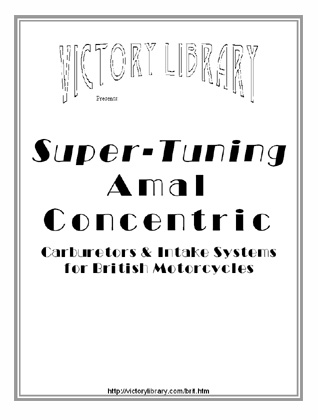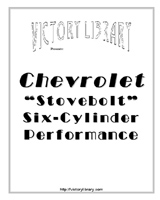|
|
 |
In this series, I will not repeat the information that is already available on how superchargers work, but instead focus on their selection, installation, use and tuning on older engines. Here I will make various observations and comments on function, and in some cases how to make improvements. New material will be added regularly, and eventually better organized. Click below to jump directly to an individual topic. |
Supercharger Topics |
|
|
|
|
|
|
Function |
|
|
|
|
|
Carburetor and intake manifold modifications |
A carburetor may be placed either before (upstream of) the supercharger, as a “draw-through” system, or after (downstream of) the supercharger, as a “blow-through” system.
Blow-through
Here the carburetor remains at or near its original position between the supercharger and the intake manifold, and only pressurized air enters it from the supercharger’s discharge port. The carburetor’s position simplifies that part of the construction somewhat (throttle & choke linkage, fuel lines, &c.), but also poses some problems:
1. the carburetor must be sealed to prevent boost from escaping. Potential air leaks include the throttle and choke shafts, air correction openings, float bowl vents, linkage holes, &c. The leakage is harmless since it’s only air, but it will reduce boost and cause an irritating noise.
2. the float bowl must be pressurized as well.
3. the air cleaner must be re-located to the supercharger’s inlet port.
4. carburetors with vacuum-based power systems (Holley, BG: power valve; Carter, Edelbrock, Rochester: metering rod) must adjust the power system
to the manifold vacuum present under no-boost conditions for mileage and plug life. The vacuum source must be below (after) the
throttle plates, and not exposed to boost from the supercharger.
5. re-jetting is needed not only for the extra air, but because a carburetor cannot “see” and react to a change in density (boost), but only to a change in velocity.
6. an intercooler between the supercharger and the engine will help suppress detonation and provide more power in high boost applications.
Size:
The carburetor’s venturi (throat) area should be about the same as the original carburetor, and no larger than the largest factory high-performance carburetor. Since flow is already pressurized as it enters the venturi, a slight reduction in size does not reduce power significantly. If response is bad, use a smaller venturi (beginning with smaller primaries). A carburetor larger than needed frequently results in lean mixture that will not respond to normal jetting changes. If boost is limited (or the mixture is too rich on top end) use a larger venturi (beginning with larger secondaries), &c. without complete new fabrication of linkage, hoses, &c.
Holley jetting:
At full throttle under boost, the engine will want more fuel than the carburetor “thinks”, since it only understands velocity in the venturi - not density.
The cruise mixture (light to mid vacuum) is controlled by the primary main jet size, so increasing this will just ruin gas mileage without providing correct mixture for boost conditions.
Full power mixture is provided when the power valve opens by adding fuel through the PVCR (power valve channel restriction, typically about .059”), which is a drilled orifice and not adjustable. This must be carefully enlarged with a needle drill.
If needed, the total fuel delivery (main jet + PVCR) can be determined by increasing only the main jet size. Example only: if the original main jet is .070” (not #70!) with an .060” PVCR, the total area is .00668”. Tuning by main jet size only, the best size is .090”, giving a total area (with the original PVCR) of .00919”. Deduct the original main jet area; the result is the new PVCR area, giving a diameter of .082”. This gives the same (correct) total fuel delivery, but since the extra fuel is only added when the power valve opens it still provides the higher mileage of the original main jet size.
In addition, high boost will require the high-speed air bleeds to be blanked off. A very small size such as .020” may work as well, but is subject to clogging with dust etc. and therefore not as reliable.
Draw-through
Here the carburetor is re-located to the supercharger’s inlet port. On a Roots-type (B&M, BDS, Camden, Chinn, Dyer, Fageol, G.M.C., Hampton, Littlefield, Marshall, Mooneyham, Ogura, Pepco, S.C.O.T., Wade, Weiand) this is above the supercharger. On an Eaton, Autorotor, Kenne-Bell, Whipple or Sprintex this will generally be behind or along side the supercharger.
Pressurized air/fuel mixture enters the engine’s intake manifold from the supercharger’s discharge port. This is the easiest method in that the carburetor never “sees” boost pressure, and operates almost normally except for re-jetting. However, there are, again, some problems:
1. all the throttle and choke linkage, fuel hoses, air cleaner, &c. must mount very close to the supercharger inlet.
2. in many cases fabrication is needed to adapt the supercharger discharge port to the engine’s intake manifold on the head.
3. fuel vaporization produces some cooling and reduces the charge temperature below ambient (that of local air), but the entire tract between the carburetor and the head (supercharger case, manifold, &c.) now contains a highly flammable gas mixture (rather than air, as in a blow-through system), with a very serious risk of explosion and fire should the engine back-fire, drop valve, &c. Because of this, a plenum or intercooler isn’t safe since it’s a potential bomb.
4. a draw-through installation must run downhill at a slight angle continuously from the carburetor to prevent fuel from puddling in the supercharger or manifold.
5. jetting adjustments are still required, but cannot enable the carburetor to distinguish between vacuum and boost.
6. the vacuum-based power system must be modified to operate in response to boost from the supercharger, rather than vacuum at the carburetor.
Size:
The optimum carburetor size is about what would support the same total power if normally aspirated, to reduce pumping loss. As a rough guess for size, use this formula:
CFM = Cubic inches Χ VE Χ RPM χ 3456
then multiply by the pressure ratio:
Pressure ratio = (boost pressure + atmospheric pressure) χ atmospheric pressure
Example: a 350” engine at 90% efficiency turning 7,000 RPM, with 10 psi boost and 14.7 psi local atmospheric pressure:
350 Χ .90 Χ 7,000 χ 3456 = 628 CFM.
(14.7 + 10) χ 14.7 = 1.68 pressure ratio
628 Χ 1.68 = 1055 CFM
As the carburetor size goes down, the pressure differential between the carburetor air-horn and the supercharger reduces boost, and increases charge temperature. Obviously, there is no point in using a total throttle plate area larger than the supercharger inlet port, but this may be enlarged in some cases without penalty.
Comments frequently appear that state very strongly that “you must run large carburetors to avoid engine damage”, “if the carburetor is too small it will run lean”, and “the minimum carburetor size needed for this application is X CFM, or Y throttle area”.
This is complete rubbish. The source has no grasp of the problem, only the results, and offers as a cure a method that insures extremely poor fuel mileage, plug fouling and other problems. In the original N/A application, the power valve is closed at idle and high vacuum conditions, and opens to admit extra fuel when vacuum drops to a pre-set level. The original carburetor size will experience continuous vacuum at all throttle openings when positioned above the supercharger, and its vacuum-operated power system will never function. The power valve will remain closed, causing a dangerous lean condition which must be cured. This, and not the carburetor size, is what causes the lean condition. Attempting to cure this by increasing the jet sizes causes the engine to run full rich at all times. The cure suggested (large carburetors) reduces vacuum to the point where the power valve, metering rod, &c. is open. This does cure the lean condition, but no longer provides accurate mixture for purposes other than full throttle.
With considerable testing, a power valve vacuum choice could be arrived at that will permit the valve to remain closed under the highest cruising speed and part-throttle acceleration the engine will see, but still open immediately upon throttle opening. This is an acceptable method, but there is no reliable way to tell in advance whether it will work or not. If the engine is too large (vs. carburetor size) vacuum will always be high. If the engine is too small (vs. carburetor size), vacuum will drop immediately upon throttle opening, and the range covered by a power valve may be too narrow to be acceptable for normal driving.
|
The carburetor can be modified to a boost-referenced power system. This references (controls) the power valve (or metering rod in Carter, Edelbrock, Rochester) to the engine rather than the supercharger. The concept is simple:
1. Find the small port in the carburetor base plate (facing the engine) that conducts vacuum internally to the power valve or metering rod. It’s probably between the two primary throttle plates.
2. Plug the hole with a piece of lead shot or a set-screw at the gasket surface in the carburetor baseplate, so that vacuum cannot enter this passage from the manifold.
3. Drill a hole horizontally in the side of the throttle body into the port above the plug.
4. Insert a tube or hose into this hole.
5. Connect the tube to a fitting in the intake manifold. This will provide vacuum to the power valve normally, but permit the valve to open and enrich mixture when vacuum drops at open throttle.
|
Here’s an excellent article that “talks you through” modifying a Holley to boost-referneced power valves:  . . |
Air inlet size
The amount of boost pressure increases the minimum area of the air scoop or stack, but higher top speed decreases it (if pointing forward).
If the inlet area is too small, boost and power will be reduced, and pumping loss increased. If the area is too large air resistance is increased, and the scoop doesn’t function as efficiently.
The formula above determines the engine’s air requirement under boost, which is then used to calculate the smallest effective air inlet size. If the top speed is very high, the correct scoop size will be surprisingly small. Click here for an excellent on-line calculator:  |
Plenum
Engines equipped with positive displacement supercharger must have a plenum, or boost storage area, between the supercharger discharge port and the engine’s intake valve. Its volume should be at least the displacement of one cylinder.
The volume of the existing plenum includes the volume of the entire tract between the rotor or vane and the intake valve, including the intake manifold plenum and runners, and is typically large enough not to require additional volume except for large 4-cylinder engines. For V8 and 6-cylinder engines this need not be a concern.
To calculate the existing volume, first take the internal volume (not capacity) of the supercharger. For a twin rotor type positive displacement this is the supercharger capacity ÷ by the number of lobes on one rotor. E.g. an Eaton M62 is 62” capacity with three lobed rotors, so its internal volume for this purpose is 62 ÷ 3 = 20.7”.
For a twin screw-type positive displacement this is the supercharger capacity ÷ by the number of lobes on the male rotor. E.g. an Autorotor 1032 is 320cc or 19.5” capacity with a four-lobed male rotor, so its internal volume for this purpose is 19.5 ÷ 4 = 4.9”.
For a vane-type positive displacement use the capacity ÷ the number of vanes. E.g. a Shorrock C75 is 750cc or 45.8” capacity with four vanes, so its internal volume for this purpose is 45.8 ÷ 4 = 11.5” (source: Harry Pyle). |
See these Victory Library booklets |

|

|

|

|

|

|

|

|

|

|

|
|
|